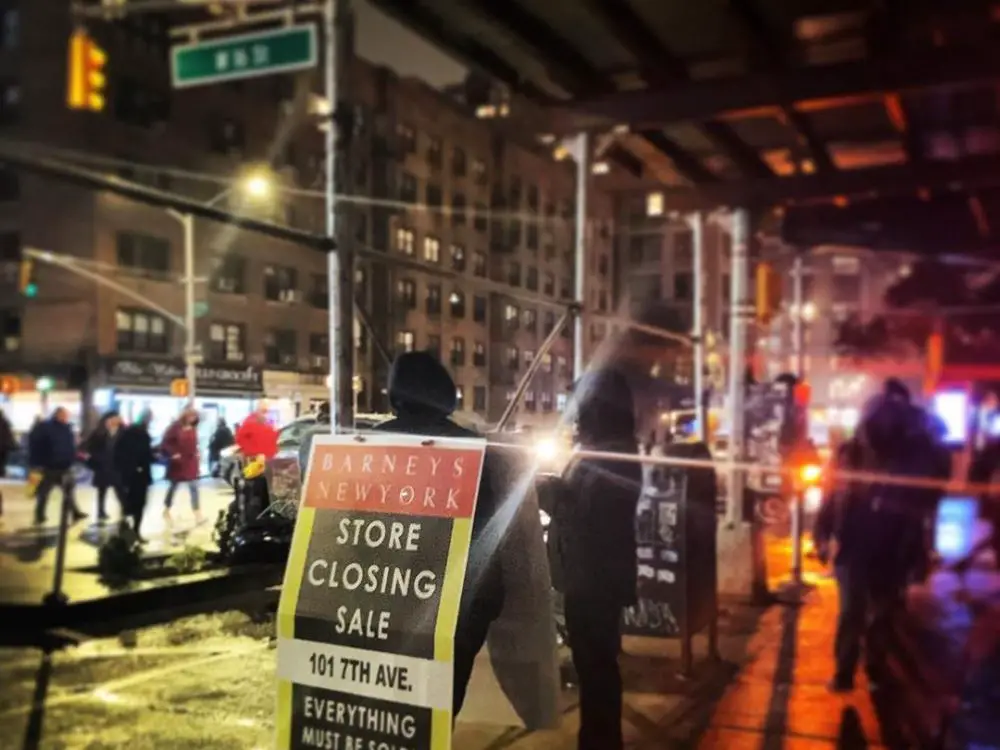This August, Barneys New York made headlines when it announced it was filing for bankruptcy, shocking many in the process. The retailer, whose Madison Avenue location was a New York institution, was founded by Barney Pressman over 95 years ago in 1923. It all started when Pressman pawned his wife’s wedding ring to buy a small clothing store in Manhattan. His mission was to provide working class customers with affordable brand name fashion that was unique and of high quality. There would be “No Bunk, No Junk, No Imitations.” He would purchase discounted inventory from showrooms, bankruptcies, closeout auctions, odd lots and newspaper ads to carry out this promise.
To sell his goods, he relied on ingenious marketing and advertising tactics. Pressman offered free alterations and free parking for customers. By the 1930s, he also used radio and television advertising to attract new customers. In order to increase brand awareness, Barneys would hold free promotional giveaways, such as giving away store-branded matchbooks to women.
Gotta love @BarneysNY marketing. pic.twitter.com/x0nOFKjUMw
— ALIZA LICHT (@AlizaLicht) October 4, 2019
Pressman’s effective strategies helped Barneys become a staple in New York. The company expanded steadily from the 1940s to the early 1960s with this business model. However, by 1964, there was a shift in their targeted demographic and in the types of products being sold. The company realized that it was simply not sustainable to sell cheap goods. As CEO Fred Pressman said, “I didn’t want to sell low-end merchandise. Now many of those who chose to are verging on bankruptcy.” The company had to meet consumer demand as tastes were shifting. The economic boom after World War II meant that Americans would have more disposable income to spend on luxury items.
The 1970s saw the continued trend of development and expansion. Barney’s focus was on opening new stores and enhancing their product selection. The company started to carry women’s clothing. They were also introducing high-end brands from Europe, such as the full line of Giorgio Armani to feed the desires of America’s upper echelon.
By the 1980s and 1990s, Barneys’ ambition rose. They opened 100 new nationwide clothing stores, including the majestic 10,000 square foot, 22-story men’s store in the World Financial Center. In addition to that, Barneys wanted to expand internationally. In 1989, they partnered up with Isetan Co. to open its first store in Japan.
It seemed that Barneys was on the rise. They were a force to be reckoned with within the luxury retail market. However, in 1996, Barney’s filed for Chapter 11 bankruptcy. Financial troubles hampered its growth as the company failed to pay off its debts. In order to resolve its issues and stay afloat, the company reorganized and sold off valuable financial assets.
From the 2000s onward, the company has been on a steep decline. Barneys’ sales have continued to slump as consumers are still reluctant to buy from them. A majority of Americans remain intimidated by its notorious elite image. Barneys fails to be inclusive as it continues to target a small demographic of wealthy individuals who indulge in luxury.
However, it appears that Barneys is losing its market share within this demographic as well. The company has tried to rebrand and create an improved image, with new retail concepts and partnerships. An example of this would be in 2011, they tried to partner up with Lady Gaga to create “Gaga’s Workshop.” Limited edition products and events were offered. This did not bring great results, however, as luxury consumers still preferred to shop at Macy’s and Nordstrom — these competitors provide more retail-friendly and technology-based services at their physical locations, including fast order pickup, a more curated selection, personal customization and access to stylist services.
#2020 pic.twitter.com/ELu33vXKYJ
— Barneys New York (@BarneysNY) November 2, 2019
In the era of fast fashion and increasing reliance on the web to buy goods, it’s also difficult for traditional retail stores to compete with e-commerce. Consumers can purchase fashion items and other goods without having to go to the physical store. Goods are then delivered directly to their homes. Barneys went under because it failed to transition toward online business.
After months of uncertainty and chaotic turmoil, it seems that Barneys has finally met an unfortunate end. As of November 2019, Authentic Brands Group has acquired Barneys New York. Most, if not all, Barneys stores would be closed, however, the Barneys name would continue to be licensed to Saks Fifth Avenue for branding.
Many will mourn while taking advantage of the liquidation sales. In their minds, Barneys will always be seen as an iconic symbol of New York and Manhattan chic. Its legacy will be preserved. Barneys will be remembered as a trendsetter in fashion, art, and pop culture.
















